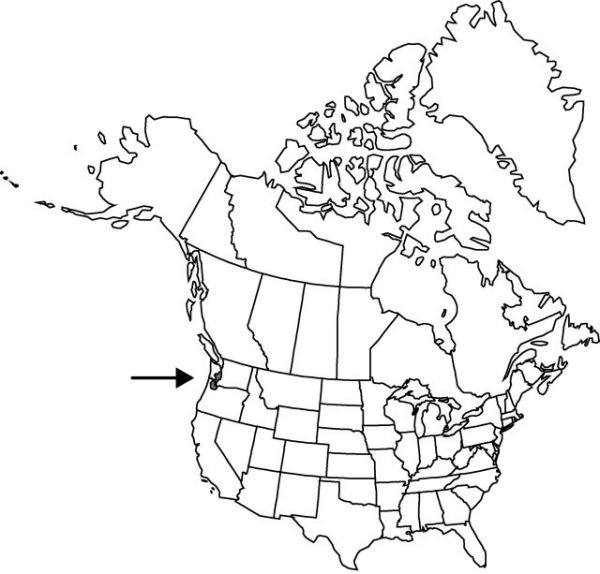Trillium parviflorum
Brittonia 32: 330, fig. 1. 1980.
Rhizomes horizontal to ± erect, brownish, thick, praemorse, not brittle. Scapes 1–3, round in cross-section, 1.7–3 dm, slender to robust, glabrous. Bracts held well above ground, sessile; blade green with widely scattered mottling, mottling becoming obscure with age, ovate to broadly ovate, 6.5–16 × 5–8 cm, not glossy, apex obtuse. Flower erect, odor spicy, of cloves; sepals displayed above bracts, spreading, divergent, green, lanceolate, 16–25 × 4–8 mm, margins entire, flat, apex variously obtuse to rounded; petals long-lasting, erect to erect-spreading, ± connivent, ± concealing stamens and ovary, white, occasionally purple stained basally, sometimes weakly spirally twisted, linear to linearlanceolate, 2.2–4.5 × 0.4–1 cm, thin-textured, base occasionally cuneate, margins entire, apex obtuse; stamens erect, 10–15.5 mm; filaments white, greenish white, or purple stained, 1–3 mm, much shorter than anthers, slender; anthers erect, straight, greenish white, 9–11+ mm, ± slender, dehiscence latrorse; connective greenish, straight, barely extended (to 0.4 mm) beyond anther sacs; ovary green or green and purple basally, ovoid, obscurely 6-gonal, 4–8 mm; stigmas erect, ± divergent, distinct, green, outer surface purple, subulate, 3–4.5 mm, ± fleshy, thickened. Fruits dark reddish purple or maroon, fragrance not reported, subglobose, ± 1 cm, ± juicy. 2n = 10.
Phenology: Flowering spring (late Mar–early May).
Habitat: Mature fir (Abies), spruce (Picea), and hardwood forests in rich humus with mosses, open, somewhat grassy large groves of old oaks, with considerable underbrush and rather few herbaceous companions, in tangled, wet stream-bank alders (Alnus sp.), grasses, open clay hillside soils among shrubs
Elevation: 20–60 m
Discussion
Trillium parviflorum varies from very short, slender, small-bracted plants to tall, broad, umbrella-bracted giants. Regardless of plant or bract sizes, flower and petal sizes are remarkably constant, all plants having small, linear-lanceolate petals. This is not usually the case with T. albidum, the species with which this plant is most likely to be confused. In T. albidum also the plants can be enormous, but when they are, the petals are very long, broad, and conspicuously obovate-diamond-shaped. In large clonal clumps of T. albidum, the larger and more mature offsets show the typical petal shape, while the smaller and presumably youngest offsets sometimes produce smaller, narrower petals, more like those of T. parviflorum.
Some western botanists, more experienced with local populations than I, do not consider Trillium parviflorum to be distinct from T. albidum. They point out that since there is an extensive region of apparent intergradation (as indeed there is, well supported by herbarium vouchers), there exists a morphological cline from the long- and wide-petaled T. albidum to the narrower- and generally shorter-petaled T. parviflorum, and that T. parviflorum, therefore, should not be considered a separate species but rather a subspecies or a variety. Since no one to date has treated T. parviflorum at the subspecific or varietal level, and since in my own limited experience it does appear as a distinct species in Washington north of the Columbia River, I include it here as treated by Soukup. I have seen populations of considerable variation north of Corvallis, Oregon, and agree that there is much overlap with T. albidum. Obviously there is need for a much more extensive study of this situation.
A factor that exacerbates this problem (and many others in Trillium), is that nutrition, age, and even favorable position in the habitat can greatly influence plant and floral organ sizes. In many species, including T. albidum, when a single vigorous clonal clump produces many offsets, the oldest offsets may have flowers with very large petals, sepals, ovary, etc., while the younger offsets may have organs only half the size. In most sessile trilliums particularly, population averages are often more useful than isolated individual measurements, a difficult situation, indeed.
Selected References
None.
Lower Taxa
"compressed-shortened" is not a number. "elongated" is not a number."thick" is not a number."dm" is not declared as a valid unit of measurement for this property."thicker" is not a number.
